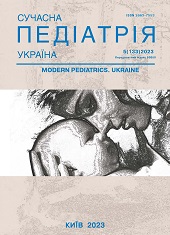Gram-positive microbiota as potential factors of healthcare-associated infections in children and adults
DOI:
https://doi.org/10.15574/SP.2023.133.58Keywords:
healthcare-associated infections (HAIs), gram-positive microbiota, hospital infection, children’s hospital, childrenAbstract
In the Lviv region, cases of healthcare-associated infections (HAIs) in children occur, but are practically not registered. For the period 2019-2021, not a single case was registered.
Purpose - to identify and compare the species composition of potential HAIs pathogens in children and adults in Lviv hospitals.
Materials and methods. Material for the study was collected from children from various biological niches who were undergoing inpatient treatment in Lviv hospitals. Identification was carried out using MIKRO-LA-TEST kits manufactured by Erba Lachema. Antibiotic susceptibility was determined according to EUCAST recommendations.
Results. Among the isolated gram-positive microbiota that meets the criteria of HAIs, enterococci were most often detected in adults (30,8%), among children (from 0 to 17 years) - in 35,4% of cases. Staphylococcus epidermidis was detected in 21,5% from children's patients, as the causative agent of the purulent-septic process, while in adults – 27,2%. A significant part of S. aureus cultures (63,6%) isolated from children was resistant to amoxicillin (among adults - 56,5%), ceftazidime (54,5%) and cefuroxime (45,4%). Among adult patients, the percentage of isolated resistant strains to ceftriaxone (65,2%), cefotaxime (52,2%), cefepime (87,0%) was significantly higher compared to such indicators in children – 9,1%, 18,2% and 36,4%. The antibiotic ceftizoxime, widely used in recent years in the treatment of children, was not effective in 45,5% of cases.
Conclusions. Despite the low level of registration of HAIs in children, this problem exists. The number of resistant strains is increasing. The sensitivity of strains to antibiotics isolated in children and adults differs significantly, so general recommendations may not be effective. The role of the clinical microbiologist and epidemiologist is extremely important for effective infection control and quality empiric antibiotic therapy in individual healthcare settings.
The research was carried out in accordance with the standarts of bioethics, approved by the ethics committee of the Danylo Halytskyi LNMU. The informed consent of the child's parents and the patient was obtained for the description of the clinical case.
No conflict of interests was declared by the authors.
References
Akinkugbe O, Cooke FJ, Pathan N. (2020). Healthcare-Associated Bacterial Infections in the Paediatric ICU. JAC-Antimicrobial Resist: 2. https://doi.org/10.1093/jacamr/dlaa066; PMid:34223023 PMCid:PMC8210264
Berezhna AV, Chumachenko TO. (2020). Sources of infection of Staphylococcus aureus isolates in the context of catheter-associated bloodstream infections: the role of microbiological monitoring in a medical and preventive institution Current issues of dermatology, vererology and HIV/AIDS infection. Materials of the scientific conference dedicated to the 160th Anniversary of Professor M.V. Typtseva: 290-294.
Berezhny VV, Mamenko ME. (2016). Intestinal Microbiota of a Newborn Child: Impact on Health, Physiological Approaches to Correction of Disorders. Pediatrician. 3: 14-20.
Dong Y, Speer CP, Glaser K. (2018). Beyond Sepsis: Staphylococcus Epidermidis Is an Underestimated but Significant Contributor to Neonatal Morbidity. Virulence. 9: 621-633. https://doi.org/10.1080/21505594.2017.1419117; PMid:29405832 PMCid:PMC5955464
Dong Y, Speer CP. (2014). The Role of Staphylococcus Epidermidis in Neonatal Sepsis: Guarding Angel or Pathogenic Devil? Int. J. Med. Microbiol. 304: 513-520. https://doi.org/10.1016/j.ijmm.2014.04.013; PMid:24881963
Korniychuk O, Tymchuk I, Pavliy S, Konechnyi Y. (2023). Healthcare-associated infections in children in Ukraine during 2009-2021. Child's health. 18 (3): 214-218. https://doi.org/10.22141/2224-0551.18.3.2023.1588
Linz MS, Mattappallil A, Finkel D, Parker D. (2023). Clinical Impact of Staphylococcus Aureus Skin and Soft Tissue Infections. Antibiotics. 12: 557. https://doi.org/10.3390/antibiotics12030557; PMid:36978425 PMCid:PMC10044708
Mani S, Chandrasekharan P. (2022). Staphylococcus Lugdunensis Bacteremia with an Infected Aortic Thrombus in a Preterm Infant. Children. 9: 46. https://doi.org/10.3390/children9010046; PMid:35053671 PMCid:PMC8774124
Ministerstvo okhorony zdorovya Ukrayiny. (2021). On the approval of changes to the criteria for determining cases of infectious and parasitic diseases that are subject to registration. Order of Ministry of Health of Ukraine 15.07.2021 # 1447. URL: https://zakon.rada.gov.ua/laws/show/z1214-21#Text
Ministry of Health of Ukraine. (2021). On the organization of infection prevention and infection control in health care institutions and institutions/institutions providing social services/social protection of the population. Order of Ministry of Health of Ukraine 03.08.2021 No. 1614. URL: https://zakon.rada.gov.ua/laws/show/z1318-21#Text.
Murni IK, Duke T, Kinney S, Daley AJ, Wirawan MT, Soenarto Y. (2022). Risk Factors for Healthcare-Associated Infection among Children in a Low-and Middle-Income Country. BMC Infect. Dis. 22: 406. https://doi.org/10.1186/s12879-022-07387-2; PMid:35473658 PMCid:PMC9040216
Westberg R, Stegger M, Söderquist B. (2022). Molecular Epidemiology of Neonatal-Associated Staphylococcus Haemolyticus Reveals Endemic Outbreak. Microbiol. Spectr: 10. https://doi.org/10.1128/spectrum.02452-22; PMid:36314976 PMCid:PMC9769988
Downloads
Published
Issue
Section
License
Copyright (c) 2023 Modern pediatrics. Ukraine

This work is licensed under a Creative Commons Attribution-NonCommercial 4.0 International License.
The policy of the Journal “MODERN PEDIATRICS. UKRAINE” is compatible with the vast majority of funders' of open access and self-archiving policies. The journal provides immediate open access route being convinced that everyone – not only scientists - can benefit from research results, and publishes articles exclusively under open access distribution, with a Creative Commons Attribution-Noncommercial 4.0 international license (СС BY-NC).
Authors transfer the copyright to the Journal “MODERN PEDIATRICS. UKRAINE” when the manuscript is accepted for publication. Authors declare that this manuscript has not been published nor is under simultaneous consideration for publication elsewhere. After publication, the articles become freely available on-line to the public.
Readers have the right to use, distribute, and reproduce articles in any medium, provided the articles and the journal are properly cited.
The use of published materials for commercial purposes is strongly prohibited.

